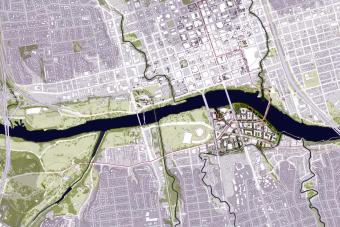The University of Texas at Austin offers a dual degree program leading to the simultaneous award of a Doctor of Jurisprudence (JD) degree and a Master of Science degree in Community and Regional Planning (MSCRP). Students enrolled in the dual degree program may receive the J.D. and MSCRP degrees in four years rather than in five years as is ordinarily required by the two programs independently.
The proposed program draws upon the resources of the two curricula with a view to developing professionals capable of dealing with both the legal and planning aspects of urban and regional policy problems. The dual degree program is designed to prepare students for a variety of professional roles in which knowledge of planning methodology and process, coupled with the analytic skills and professional expertise of lawyers, are essential. These may include private practitioners in law and planning; administrators and staff of public agencies and consulting firms in the fields of planning, housing, and environmental protection; research analysts; staff members of governmental commissions and agencies; and executive assistants to elected and appointed officials.
The University of Texas at Austin is well-positioned to offer a high-quality program of this nature, with distinguished professors within both programs who are recognized or their scholarship and teaching, as well as the extraordinary academic resources on campus. The Tarlton Law Library is the fifth largest academic library in the United States and has strong government, land use, and environmental law holdings. The Public Affairs, Perry-Castaneda, and Architecture and Planning Libraries provide strong coverage for all aspects of community and regional planning. The Center for Public Policy Dispute Resolution also provides a forum for faculty from both academic units to collaborate in the study and resolution of conflict at community and regional levels.
PROGRAM STRUCTURE
Both degrees are awarded simultaneously upon completion of all requirements of the dual program. Therefore, students should arrange their course schedules so that the requirements for both degree programs are completed in the same semester.
Students may begin their joint degree in either program. Students must complete the entire first year Law curriculum in their first year at the Law School. The Law School’s first-year curriculum includes six one-semester four-unit substantive law courses: Civil Procedure, Constitutional Law I, Contracts, Criminal Law, Property, and Torts. One of these six courses will include a writing component, which adds a unit of credit to the course. The rest of the first-year curriculum includes two semesters of Legal Research and Writing (two units of credit per semester) and an optional elective course of 2-3 units in the spring semester. The first year program in the Law School usually totals 29 units of credit.
Students must also complete the Law School’s upper-class curriculum that includes the following requirements: Professional Responsibility, Constitutional Law II, a writing seminar, and a Professional Skills course.
ADMISSIONS
Students must apply separately to both the Law School and the graduate program in Community and Regional Planning and must be accepted independently by both programs. Students must have completed the GRE and LSAT tests so that test scores are available by respective admission deadlines of each school.
A prospective dual degree student may apply in two ways. First, the candidate can apply to the Law and CRP programs simultaneously. Alternatively, during the student’s first year of Law School or first year in the CRP program (and prior to applicable deadlines), the student can apply for admission to the dual-degree program.
COURSE REQUIREMENTS
A minimum of 110 credit hours must be completed to receive the dual degrees: 80 credit hours must be completed in Law School coursework and 30 credit hours completed in Planning. Six of the Planning credit hours of the student’s area of specialization apply toward the completion of the 86 credit hour minimum for the award of the J.D. degree; and 18 credit hours of the student’s Law School coursework applicable to the student’s area of specialization apply toward the completion of the 48 hour minimum for the award of the MSCRP degree.
COMMUNITY AND REGIONAL PLANNING
Students must complete a total of 30 hours of Planning course work, including the MSCRP core curriculum and a professional report in Community and Regional Planning. As previously noted, 18 credit hours of the student’s Law School course work applicable to the student’s area of specialization will apply toward the completion of the 48-hour minimum for the award of the MSCRP degree. Students may choose to take a course in alternative dispute resolution (for Law School credit) to satisfy the CRP core requirements for Participatory Planning. Students may also choose to satisfy the CRP core requirement for Planning Law by taking CRP 381 (Planning Law) for either Law School or CRP credit.
Students in the dual degree program must complete a professional report in the final year of study that makes full use of the combined degree education. The professional report must be read and approved by a supervising professor (from CRP) and at least one second reader (from either school). Except as set forth above, all degree requirements applicable to students of the Community and Regional Planning degree program apply to students in the dual degree program.
LAW SCHOOL
All Law School requirements applicable to students in the normal JD program must be satisfied. The JD degree normally requires 86 total units. For dual degree students in the JD/MSCRP program, six of the 86 total credit hours for the award of the JD degree shall be completed in Community and Regional Planning. The remaining balance of 80 credits must be taken in the Law School.
CONTACT
Jake Wegmann
Associate Professor
Graduate Adviser for Community and Regional Planning
jagw@utexas.edu
OTHER DUAL DEGREES

MSCRP + PUBLIC AFFAIRS


